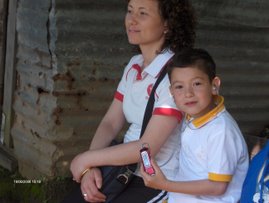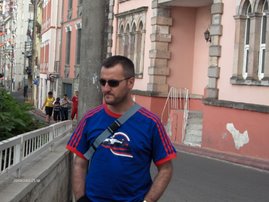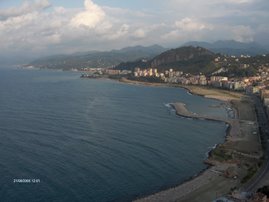Oruç Reis
Oruç Reis, (1470-1518) Türk denizcisi . Bir süre için Cezayir valiliği yapmıştır.
Hayatı
Muhtemelen 1470 yılında osmanlı yerleşkesi olan şu an ki Midilli’nin Bonova köyünde doğdu. Babası, Yâkub Ağa, 1462’de Midilli’nin fethine katılmış ve Bonova köyü kendisine tımar olarak verilmişti. Burada yerleşip evlenen Yâkub Ağanın İshak, Oruç, Hızır ve İlyas adını verdiği dört oğlu olmuştu. İyi bir öğrenim gören kardeşler, devrin denizci milletlerinin lisanları olan İtalyanca, İspanyolca, Fransızca ve Rumca'yı öğrenerek yetiştiler. Gençliğinde gemiciliği ve deniz ticaretini çok iyi öğrenen Oruç Reis, cesareti, zekası ve girişimciliği ile kısa zamanda gemi sahibi oldu. Suriye, Mısır, İskenderiye ve Trablusşam’a mal taşıyarak, oradan aldıklarını Anadolu’ya getiriyordu.
Oruç ve İlyas reisler, bir seferinde Midilli’den Trablusşam’a giderken, Rodos şövalyelerinin büyük savaş gemileriyle karşılaştılar. Çarpışmada İlyas Reis şehit düştü, Oruç Reis esir oldu. Rodos’ta zindana atılan Oruç Reis, çok eziyet ve sıkıntı çekti. Uzun uğraşmalardan sonra, buradan kurtuldu. Muhtemelen üç sene esir kalan Oruç Reis, esaretten kurtulduktan sonra, bir süre Memlük Devleti hizmetinde amirallik yaptı. Burada uzun zaman kalmayıp, Şehzade Korkut’un verdiği on sekiz büyük savaş gemisine komutan oldu. Bunlarla, Rodos kıyılarında basılmadık yer bırakmayan Oruç Reis, ânî bir baskın sonucunda gemilerini kaybetti. Leventleriyle birlikte bu baskından kurtulduktan sonra, Şehzâde Korkut’a tekrar başvurdu. Kendisine, biri yirmi dört oturak, ikincisi yirmi iki oturak iki savaş gemisi verildi. Şehzâde Korkut’un elini öpüp, hayır duâsını aldıktan sonra Akdeniz’e açıldı. Seferlerinde pek çok ganîmet, ticaret malı ve esir aldı. On senedir uğramadığı Midilli’ye gelerek kardeşlerine, akrabalarına, fakir ve muhtaçlara, yetimlere pek çok mal dağıttı.
Türk denizcilik târihinde önemli bir yeri olan Cerbe Adası, Oruç Reis tarafından 1513 yazında fethedildi. Burayı kendisine üs edinip, Doğu ve Batı Akdeniz’de pek çok gemi zaptetti. [Papa]]’ya ait, o zamanın dev savaş gemilerini, ince tekneleriyle ele geçirmesi, şöhretini Avrupa ve İslâm dünyâsının hepsine ulaştırdı.
O tarihe kadar, bir çektirinin, bir baştardayı ele geçirmesi işitilmemişti. Gemi elde edilince kendisi dahil bütün leventlerine İtalyan elbiselerini giydirdi. Oruç Reisin, arkadan gelen ikinci savaş gemisini ele geçirmesi, pek kolay oldu. Zîrâ ateş başlayıncaya kadar, İtalyanlar, bu gemiyi kendi gemileri zannetmişlerdi.
Cezayir’de bir devlet kurmaya karar veren Oruç Reis, kısa zamanda bu toprakları ele geçirdi. İspanya Kralı Şarlken, Cezayir’e donanma gönderdiyse de, Oruç Reis’i elde ettiği yerlerden çıkaramadı. Becâye kuşatması sırasında Oruç Reis, sol kolundan ağır yaralandı ve hekimlerin tavsiyesiyle bu kolu dirsekten kesildi. Tek kolla mücadelede de şevk ve azminden hiçbir şey kaybetmeyen büyük deniz kurdu, iyileşince derhal denize açıldı ve pek çok gemi ele geçirdi. Çok güç durumda olan Endülüs Müslümanlarına yardım ederek, onların binlercesini Kuzey Afrika’ya taşıdı. Bu hareketleri İslâm dünyasındaki saygısını arttırdı. Kardeşleriyle Kuzey Afrika’yı Hristiyanlara karşı savunmakla kalmayıp, Endülüs Müslümanlarından gelenleri iskân ediyor, yiyecek ve diğer ihtiyaçlarını temin ediyordu. Elindeki bir leventle, İslamı yaymaktan başka bir düşünceleri olmayan akıncılar serdengeçtilerle, devrin en büyük denizci Hristiyan devleti olan İspanyollarla bitmek tükenmek bilmeyen mücadelelerine devâm ediyordu. İspanya kralı, Avrupa’nın pek çok ülkesini elinde bulundurduğu gibi, Amerika’da da sömürgeleri vardı.
Cezayir’in doğusunda, İspanya’nın hakimiyeti altında bulunan Tlemsan’ı elde eden Oruç Reis, İspanyollardan yardım alan Tlemsan emirine karşı, elde ettiği yerleri savundu. Topraklarını yedi ay boyunca müdâfaa etti. Yerli halkın ihanet etmesi üzerine, Cezayir’e dönmek için düşman kuşatmasını yarıp dışarı çıkmaya çalıştı. Düşmanı yararak bir kısım leventleriyle birlikte ırmağı geçti. Ancak, yirmi kadar levendi, düşman tarafında kalmıştı. Oruç Reis, kurtulma ümîdi olmadığını bile bile, leventlerini yalnız bırakmamak için tekrar düşmanları arasına daldı. Nehri geçmeye çalışırken leventlerinin çoğu şehit oldu. Tek kollu Oruç Reis, yanındaki son levendin de öldüğünü gördükten sonra, aldığı iki ok yarası sonucu Rio Solado Nehri sularına düşüp, öldü.
1518’de şehit olduğunda, kırk sekiz yaşında olduğu tahmin edilmektedir.
Karakteri
Sınır boylarında akıncıların yaptıkları, yıldırma ve fethe hazırlama faaliyetlerini denizde gerçekleştiren cesaret ve kahramanlık timsâli deniz kurtlarından biri olan Oruç Reis, katıldığı muharebede can ve mal endişesi duymazdı. Elde ettiği ganimetleri fakir ve kimsesizlere, leventlerine dağıtır, varını yoğunu cihâd ve gazâ için sarfederdi. Cömert, âlicenap, yardımsever, merhametli olan Oruç Reis, ciddî ve sertti. Bütün leventleri tarafından, bir baba gibi sevilirdi. Çok iyi bir muhârip, tehlikeli zamanlarda en iyi çareleri bulmakta zorluk çekmeyen bir komutan, İslâmiyeti yaymaktan başka bir şey düşünmeyen korkusuz, cüretkâr ve zekî bir insandı.
Aruj or Oruc Reis (Turkish: Oruç Reis) (c. 1474-1518) was a Turkish privateer and Ottoman Bey (Governor) of Algiers and Beylerbey (Chief Governor) of the West Mediterranean. He was born on the island of Midilli (Lesbos) in today's Greece and was killed in a battle with the Spaniards in Algeria.
He became known as Baba Aruj or Baba Oruç (Father Aruj) when he transported large numbers of Mudejar refugees from Spain to North Africa; in the Christian countries of the Mediterranean he was known as Barbarossa, which meant Redbeard in Italian.
He was the older brother of the famous Turkish privateer and Ottoman admiral Hayreddin Barbarossa.
Background
Oruç was one of four brothers who were born in the 1470s on the island of Lesbos (Λέσβος) to their Muslim Turkish father, Yakup Ağa, and his Christian Greek wife, Katerina. According to Ottoman archives Yakup Ağa was a Tımarlı Sipahi, i.e. a Turkish feudal cavalry knight, whose family had its origins in Eceabat and Balıkesir, and later moved to the Ottoman city of Vardar, near Thessaloniki. Yakup Ağa was among those appointed by Sultan Mehmed II to capture Lesbos from the Genoese in 1462, and he was granted the fief of Bonova village as a reward for fighting for the cause. He married a local Greek girl from Mytilene named Katerina, and they had two daughters and four sons: Ishak, Oruç, Hızır and Ilyas. Yakup became an established potter and purchased a boat of his own to trade his products. The brothers helped their father with his business, but not much is known about the sisters.
Early career
All four brothers became seamen, engaged in marine affairs and international sea trade. Oruç was the first brother to be involved in seamanship, soon joined by the youngest brother Ilyas. Hızır initially helped their father in the pottery business, but later obtained a ship of his own and also began a career at sea. Ishak, the eldest, remained on Mytilene and was involved with the financial affairs of the family business. The other three brothers initially worked as sailors, but then turned privateers in the Mediterranean, counteracting the privateering of the Knights of St. John of the Island of Rhodes. Oruç and Ilyas operated in the Levant, between Anatolia, Syria and Egypt, while Hızır operated in the Aegean Sea and based his operations mostly in Thessaloniki.
Oruç was a very successful seaman. He also learned to speak Italian, Spanish, French, Greek and Arabic in the early years of his career. While returning from a trading expedition in Tripoli, Lebanon, he and Ilyas were attacked by a galley of the Knights of St. John. Ilyas was killed in the fight, and Oruç was wounded. Their father's boat was captured, and Oruç was taken prisoner and detained in the Knights' Bodrum Castle for nearly three years. Upon learning the location of his brother, Hızır went to Bodrum and managed to help Oruç escape.
Oruç Reis the corsair
Oruç later went to Antalya, where he was given 18 galleys by Shehzade Korkud, an Ottoman prince and governor of the city, and charged with fighting against the Knights of St. John who inflicted serious damage on Ottoman shipping and trade. In the following years, when Shehzade Korkud became governor of Manisa, he gave Oruç Reis a larger fleet of 24 galleys at the port of İzmir and ordered him to participate in the Ottoman naval expedition to Puglia in Italy, where Oruç bombarded several coastal forts and captured two ships. On his way back to Lesbos, he stopped at Euboea and captured three galleons and another ship. Reaching Mytilene with these captured vessels, Oruç learned that Shehzade Korkud, brother of the new Ottoman sultan, had fled to Egypt in order to avoid being killed because of succession disputes -- a common practice at that time in the House of Osman. Fearing trouble due to his well-known association with the Ottoman prince in exile, Oruç sailed to Egypt where he met Shehzade Korkud in Cairo and managed to get an audience with the Mamluk Sultan Qansuh al-Ghawri, who gave him another ship and charged him to raid the coasts of Italy and the islands of the Mediterranean that were controlled by Christian powers. After passing the winter in Cairo, he set sail from Alexandria and operated along the coasts of Liguria and Sicily.
In 1503 Oruç Reis managed to seize three more ships and made the island of Djerba his new base, thus moving his operations to the Western Mediterranean. Hızır joined Oruç Reis at Djerba. In 1504 the two brothers asked Abu Abdullah Mohammed Hamis, sultan of Tunisia from the Beni Hafs dynasty, for permission to use the strategically located port of La Goulette for their operations. They were granted this right, with the condition of leaving one third of their booty to the sultan. Oruç Reis, in command of small galliots, captured two much larger Papal galleys near the island of Elba. Later, near Lipari, the two brothers captured a Sicilian warship, the Cavalleria, with 380 Spanish soldiers and 60 Spanish knights from Aragon on board, who were on their way from Spain to Naples. In 1505 they raided the coasts of Calabria. These accomplishments increased their fame and they were joined by a number of other well-known Muslim corsairs, including Kurtoğlu (known in the West as Curtogoli.) In 1508 they raided the coasts of Liguria, particularly Diano Marina.
In 1509 Ishak also left Mytilene and joined his brothers at La Goulette. The fame of Oruç Reis increased when between 1504 and 1510 he transported Muslim Mudejars from Christian Spain to North Africa. His efforts of helping the Muslims of Spain in need and transporting them to safer lands earned him the honorific name Baba Oruç (Father Aruj), which eventually— due to the similarity in sound— evolved in Spain, Italy and France into Barbarossa (Redbeard in Italian).
In 1510 the three brothers raided Cape Passero in Sicily and repulsed a Spanish attack on Bougie, Oran and Algiers. In August 1511 they raided the areas around Reggio Calabria in southern Italy. In August 1512 the exiled ruler of Bougie invited the brothers to drive out the Spaniards, and during the battle Oruç Reis lost his left arm. This incident earned him the nickname Gümüş Kol (Silver Arm in Turkish), in reference to the sliver prosthetic device which he used in place of his missing limb. Later that year the three brothers raided the coasts of Andalusia in Spain, capturing a galliot of the Lomellini family of Genoa who owned the Tabarca island in that area. They subsequently landed on Minorca and captured a coastal castle, and then headed towards Liguria and captured four Genoese galleys near Genoa. The Genoese sent a fleet to liberate their ships, but the brothers captured their flagship as well. After capturing a total of 23 ships in less than a month, the brothers sailed back to La Goulette.
There they built three more galliots and a gunpowder production facility. In 1513 they captured four English ships on their way to France, raided Valencia where they captured four more ships, and then headed for Alicante and captured a Spanish galley near Málaga. In 1513 and 1514 the three brothers engaged Spanish squadrons on several other occasions and moved to their new base in Cherchell, east of Algiers. In 1514, with 12 galliots and 1,000 Turks, they destroyed two Spanish fortresses at Bougie, and when a Spanish fleet under the command of Miguel de Gurrea, viceroy of Majorca, arrived for assistance, they headed towards Ceuta and raided that city before capturing Jijel in Algeria, which was under Genoese control. They later captured Mahdiya in Tunisia. Afterwards they raided the coasts of Sicily, Sardinia, the Balearic Islands and the Spanish mainland, capturing three large ships there. In 1515 they captured several galleons, a galley and three barques at Majorca. Still in 1515 Oruç Reis sent precious gifts to the Ottoman Sultan Selim I who, in return, sent him two galleys and two swords embellished with diamonds. In 1516, joined by Kurtoğlu, the brothers besieged the Castle of Elba, before heading once more towards Liguria where they captured 12 ships and damaged 28 others.
Ruler of Algiers
In 1516 the three brothers succeeded in liberating Jijel and Algiers from the Spaniards, but eventually assumed control over the cities and surrounding region, forcing the previous ruler, Abu Hamo Musa III of the Beni Ziyad dynasty, to flee. The local Spaniards in Algiers sought refuge in the island of Peñón near Algiers and asked Emperor Charles V, King of Spain, to intervene, but the Spanish fleet failed to force the brothers out of Algiers.
After consolidating his power and declaring himself the new Sultan of Algiers, Oruç Reis sought to enhance his territory inlands and took Miliana, Medea and Tenes. He became known for attaching sails to cannons for transport through the deserts of North Africa. In 1517 the brothers raided Capo Limiti and later the Island of Capo Rizzuto in Calabria.
Algiers joins the Ottoman Empire
For Oruç Reis the best protection against Spain was to join the Ottoman Empire, his homeland and Spain's main rival. For this he had to relinquish his title of Sultan of Algiers to the Ottomans. He did this in 1517 and offered Algiers to the Ottoman Sultan. The Sultan accepted Algiers as an Ottoman Sanjak (province), appointed Oruç as the Bey (Governor) of Algiers and Beylerbey (Chief Governor) of West Mediterranean, and promised to support him with janissaries, galleys and cannons.
Final engagements and death of Oruç Reis and Ishak
The Spaniards ordered Abu Zayan, whom they had appointed as the new ruler of Tlemcen and Oran, to attack Oruç Reis by land, but Oruç learned of the plan and pre-emptively struck against Tlemcen, capturing the city and executing Abu Zayan. The only survivor of Abu Zayan's dynasty was Sheikh Buhammud, who escaped to Oran and called for Spain's assistance.
In May 1518 Emperor Charles V arrived at Oran and was received there by Sheikh Buhammud and the Spanish governor of the city, Diego de Cordoba, marquess of Comares, who commanded a force of 10,000 Spanish soldiers. Joined by thousands of Bedouins, the Spaniards marched overland on Tlemcen where Oruç Reis and Ishak awaited them with 1,500 Turkish and 5,000 Moorish soldiers. They defended Tlemcen for 20 days, but were eventually killed in combat by the forces of Garcia de Tineo.
The last remaining brother, Hızır Reis, inherited his brother's place, his name (Barbarossa) and his mission.
Legacy
Oruç Reis established the Turkish presence in North Africa which lasted 4 centuries, de facto until the loss of Libya to Italy in 1912 and de jure until the official loss of Egypt to the United Kingdom in 1914, after the Ottoman Empire joined World War I on the side of the Central Powers. The Republic of Turkey officially renounced the remaining disputed Turkish rights in some territories of Egypt with the Treaty of Lausanne in 1923.
Several submarines of the Turkish Navy have been named after Oruç Reis (see Oruç Reis class submarine).


















Hiç yorum yok:
Yorum Gönder